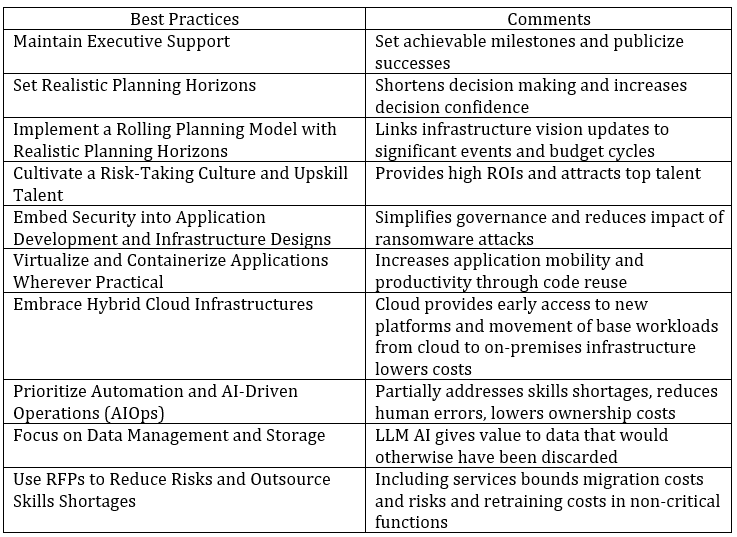Introduction
In today’s fast-changing digital world, IT infrastructure can be a business enabler—or a bottleneck. While adopting hybrid multi-clouds and AI infrastructure managed by AIOps boosts agility and operational efficiency, long-term competitive advantage requires more. It demands alignment between IT investments and digital needs, a culture that embraces change, and development methods that prioritize business continuity, security, and application mobility. Without mobility, responding to changes in business strategies or failed digital business initiatives can quickly create expensive technical deficits.
These efforts need strong executive backing. Future-proofing demands cross-functional cooperation and the willingness to take risks. Without executive support, IT investments often become fragmented and business-unit-driven, reducing overall effectiveness.
The best practices below reflect the persistent challenges CIOs face, especially in resource-constrained environments. See Appendix for a list of these challenges.
Best Practices Overview

1.. Implement Rolling Planning Model with Realistic Planning Horizons
Effective infrastructure planning balances short- and long-term needs. Typical planning windows are 3–5 years for compute and storage, and 5–7 for networking. Overextending equipment lifecycles can lead to higher maintenance costs and limit vendor responsiveness.
Planning too far ahead can lead to inefficiencies, such as delaying decision making, over-provisioning, and investing in solutions that are made obsolete by new technologies and shifting business strategies. On the other hand, overly short-term planning can result in a collection of incompatible systems that cannot effectively share data. A rolling planning model linked to budgeting and major project timelines improves agility and ensures relevance.
Planning software refreshes is more complex due to retraining costs, strong vendor lock-ins often accompanied by longer contractual commitments, and integration issues. Refreshes should consider not only technology fit but also user experience and operational continuity. Hence, software vendor changes are often driven by dissatisfaction with functionality, performance, cost, support, or integration with other hardware and software ecosystems; factors that are difficult to predict.
2. Cultivate a Risk-Taking Culture and Upskill Talent
Future-proofing isn't just about technology—it’s about people. Organizations must encourage experimentation and treat failure as a learning opportunity. Upskilling in cloud, cybersecurity, DevOps, and AI ensures that staff are ready for emerging challenges.
This focus on human capital increases agility, fosters a culture of sustainable innovation, and delivers high ROIs. People are more still more adaptable than code.
3. Embrace Hybrid Cloud Infrastructures
Pure on-prem infrastructure rarely meets modern enterprise needs. Hybrid clouds – the blending public, private, and on-prem systems - enables workload optimization across cost, performance, scale, and security.
They also facilitate smoother legacy-to-modern transitions and support incremental migration, minimizing disruption.
4. Use RFPs to Reduce Risk and Address Skill Shortages
IT teams often stick with incumbents to avoid retraining and migration headaches. However, RFPs should address full lifecycle costs: initial deployment, migration, upgrades, and ongoing support.
Expanding RFPs to include services like retraining and post-deployment support clarifies expectations and safeguards against underperformance. Remedies tied to service timelines can enforce accountability.
Where skill shortages persist, outsourcing non-core functions to managed service providers (MSPs) can shrink opportunity costs, even if these are hard to quantify.
5. Prioritize Automation and AIOps
Manual oversight in large environments is no longer viable. Automation reduces human error and enhances speed. AIOps adds intelligence by using machine learning to detect anomalies and predict outages.
This shift allows IT to move from reactive firefighting to proactive service delivery, making infrastructure more resilient and self-healing.
6. Focus on Data Management and Storage
Data growth is exponential—and valuable. Effective future-proofing includes scalable storage (e.g., object or cloud-native), plus robust backup, recovery, and compliance strategies.
Large language models (LLMs) can now extract value from data once considered expendable. This makes data governance and accessibility even more critical.
7. Embed Security in Development and Design
Security must be integral—not an afterthought in application design and development. Embedding secure coding, Zero Trust architectures, and automated vulnerability scans ensure that systems are hardened and compliant from the ground up.
This reduces the attack surface, enhances governance, and aligns security with business agility.
8. Virtualize and Containerize Applications
Wherever possible, decouple applications from hardware. Virtualization supports disaster recovery and simplifies migration. Containerization (e.g., using Kubernetes) ensures consistent, portable environments that speed up development and scale easily across cloud environments.
These technologies reduce vendor lock-in and strengthen hybrid/multi-cloud strategies.
9. Require Business Units to Forecast IT Needs
Unpredictable demand from business units hampers IT’s ability to plan. Requiring 2–3 year forecasts for software, application deployments and retirements, and infrastructure needs improves visibility, optimizes procurement, and reduces emergency spending.
This also encourages greater alignment between business and IT planning cycles.
10. Implement Chargeback Models that Reward Accuracy
While unpopular, chargebacks improve accountability. When tied to accurate forecasting and consumption models (e.g., reserved vs. spot pricing), they create incentives for better planning.
Even in organizations that avoid strict chargebacks, partial models that reward accurate forecasting promote responsible resource use and better collaboration.
Conclusion
Future-proofing IT infrastructure is an ongoing, multi-dimensional challenge. It requires strategic foresight, cultural adaptation, and smart technology adoption. By aligning planning with real-world constraints, developing talent, integrating automation and security, and optimizing cloud and data strategies, organizations build adaptable, efficient, and resilient infrastructures.
The reward? Infrastructure that not only supports today’s needs—but enables tomorrow’s innovation.
Appendix: Perpetual CIO Challenges
- Ensuring infrastructure resilience and business continuity
- Demonstrating IT’s business value
- Addressing persistent cybersecurity threats
- Recruiting and retaining top technical talent
- Integrating AI responsibly and effectively
- Meeting evolving regulatory demands
- Balancing innovation with operational stability
- Managing increasingly complex technology stacks
---- ---- ---- ---- ---- ----
Stanley Zaffos
Advisor at Lionfish Tech Advisors, Inc.
_____________________________________
©2025 Lionfish Tech Advisors, Inc. All rights reserved.
Title background image source:: Strikingly gallery.